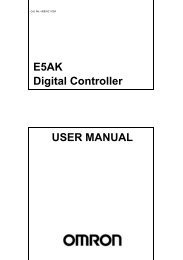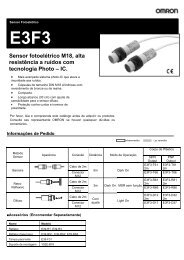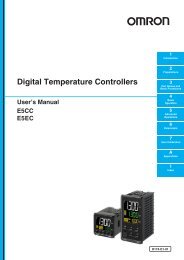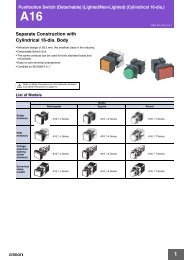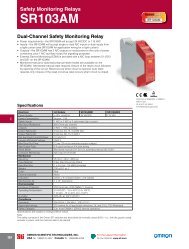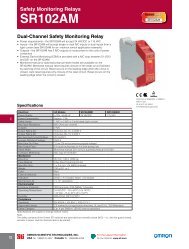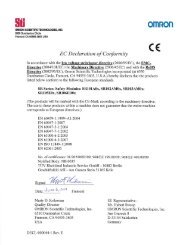E3F2-240VAC - OMRON
E3F2-240VAC - OMRON
E3F2-240VAC - OMRON
You also want an ePaper? Increase the reach of your titles
YUMPU automatically turns print PDFs into web optimized ePapers that Google loves.
Safety precautions<br />
This product is not designed or rated for directly or<br />
indirectly ensuring safety of persons. Do not use it for<br />
such a purpose.<br />
Do not use the product with voltage in excess of the<br />
rated voltage. Excess voltage may result in malfunction<br />
or fire.<br />
When cleaning the product, do not apply a high-pressure<br />
spray of water to one part of the product. Otherwise,<br />
parts may become damaged and the degree of<br />
protection may be degraded.<br />
High-temperature environments may result in burn<br />
injury.<br />
The following precautions must be observed to ensure safe<br />
operation of the Sensor.<br />
Operating Environment<br />
Do not use the Sensor in an environment where explosive or<br />
flammable gas is present.<br />
Load<br />
Do not use a load that exceeds the rated load. Do not connect the<br />
black wire to the brown wire without a load. Direct connection of<br />
these wires may damage the photoelectric sensor<br />
Sensor<br />
When you use the photoelectric sensor at temperatures exceeding<br />
45°C, the load current must be within the described values as shown<br />
in the figure below.<br />
Load current (mA)<br />
200<br />
130<br />
! Warning<br />
! Caution<br />
Precautions for Safe Use<br />
0<br />
Brown<br />
Black<br />
Blue<br />
Load<br />
24 to 240 VAC<br />
45<br />
Operating temperature (˚C)<br />
55<br />
Environements with Cleaners and Disinfectants<br />
(e.g., Food Processing Lines)<br />
Do not use the Sensor in environments subject to cleaners and<br />
disifectants. They may reduce the degree of protection.<br />
Modifications<br />
Do not attempt to disassemble, repair, or modify the Sensor.<br />
Outdoor Use<br />
Do not use the Sensor in locations subject to direct sunlight.<br />
Cleaning<br />
Do not use thinner, alcohol, or other organic solvents. Otherwise,<br />
the optical properties and degree of protection may be degraded.<br />
Surface Temperature<br />
Burn injury may occur. The Sensor surface temperature rises depending<br />
on application conditions, such as the surrounding temperature<br />
and the power supply voltage. Use caution when<br />
operating or washing the Sensor.<br />
Precautions for Correct Use<br />
Do not use the Sensor in any atmosphere or environment that<br />
exceeds the ratings.<br />
Do not install the Sensor in the following locations.<br />
(1)Locations subject to direct sunlight<br />
(2)Locations subject to condensation due to high humidity<br />
(3)Locations subject to corrosive gas<br />
(4)Locations where the Sensor may receive direct vibration or<br />
shock<br />
Connecting and Mounting<br />
(1)Laying Sensor wiring in the same conduit or duct as high-voltage<br />
wires or power lines may result in malfunction or damage<br />
due to induction. As a general rule, wire the Sensor in a separate<br />
conduit or use shielded cable.<br />
(2)Do not pull on the cable with excessive force.<br />
(3)Do not subject the photoelectric sensor to excessive shock<br />
when mounting, in keeping with IP66 standards.<br />
(4)Mount the Sensor using a bracket (sold separately).<br />
Do not exceed a torque of 2.0 Nm when tightening mounting<br />
nuts.<br />
Cleaning<br />
Never use thinner or other solvents. Otherwise, the Sensor surface<br />
may be dissolved.<br />
Water Resistance<br />
Do not use the Sensor in water, rainfall, or outdoors.<br />
6 Standard Photoelectric Sensors



